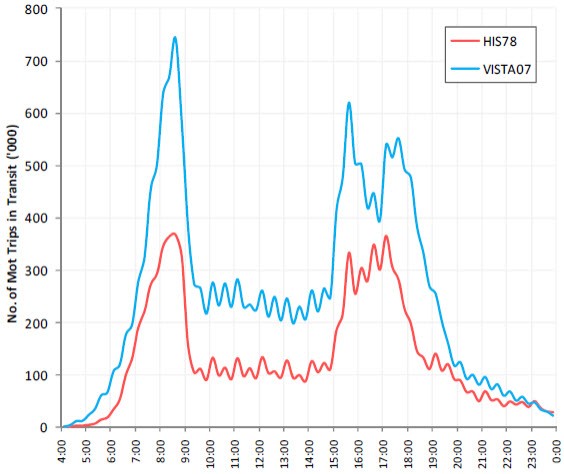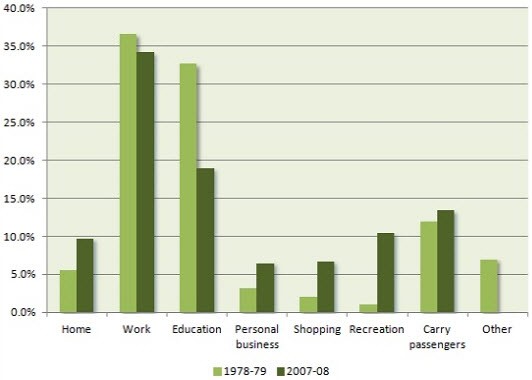Here’s something we don’t often see — how travel behaviour has changed over long periods of time, in this case three decades …

It’s taken from a paper by Craig Mcgeoch, a transport analyst at engineering consultants Arup. While it’s specifically about Melbourne, it tells a story that applies in general terms to all our large cities.
McGeoch examined travel behaviour from the 1978/79 Melbourne Home Interview Travel Survey (HIS) and compared it with data from the 2007/08 Victorian Integrated Survey of Travel and Activity (VISTA). This is a fraught task– there are lots of small ways in which these surveys might differ — so it’s best to focus on the broader patterns.
The first exhibit shows that the number of weekday trips by motorised modes (i.e. by car and public transport) increased massively over the 30 years, doubling in the morning peak and inter-peak periods.
The morning peak in particular is now very tall. That has significant implications for infrastructure provision, as sufficient capacity — both capital and operating — has to be provided to meet that very sharp and very brief peak. It’s extraordinarily inefficient because for most of the day the greater part of that capacity remains unutilised.
The graph also shows how a second afternoon peak has emerged at around 3.30pm, reflecting the rapid growth in the number of parents driving children to school. Indeed, the school pick-up is now more “peaked” than the traditional work finishing time (which is now much later).
Here’s further insight into the way travel behaviour has changed: this graph shows journeys to work only account for around a third of all trips in the morning peak. This isn’t an entirely new phenomenon — it’s true for both 1978/79 and 2007/08.

Education remains an important trip purpose in the morning peak but it’s much less significant now than it was 30 years earlier, probably as a result of more parents driving children to school on their way to work (these are linked trips, so they show the main purpose).
Despite the growth in traffic, shopping and recreation trips have increased dramatically — they now comprise 17.1% of morning peak trips, up from only 3.0% in 1978/79. Rather than build additional capacity, there is considerable scope to encourage a large proportion of those discretionary shopping and recreational trips to shift to the shoulder of the peak or even to the off-peak.
There are various policy options for cutting off the “tip” of the peak by managing demand better — for example, in the case of roads, congestion pricing would give travellers an “incentive” to look for alternative travel times. Demand management options are important because the peak, despite its brevity and the relatively small number of travellers in the “tip”, is the customary rationale for investing in additional road and rail capacity.
Victoria’s Premier Denis Napthine would do well to think about that as he prepares to spend billions on the East-West Link.








Crikey encourages robust conversations on our website. However, we’re a small team, so sometimes we have to reluctantly turn comments off due to legal risk. Thanks for your understanding and in the meantime, have a read of our moderation guidelines.